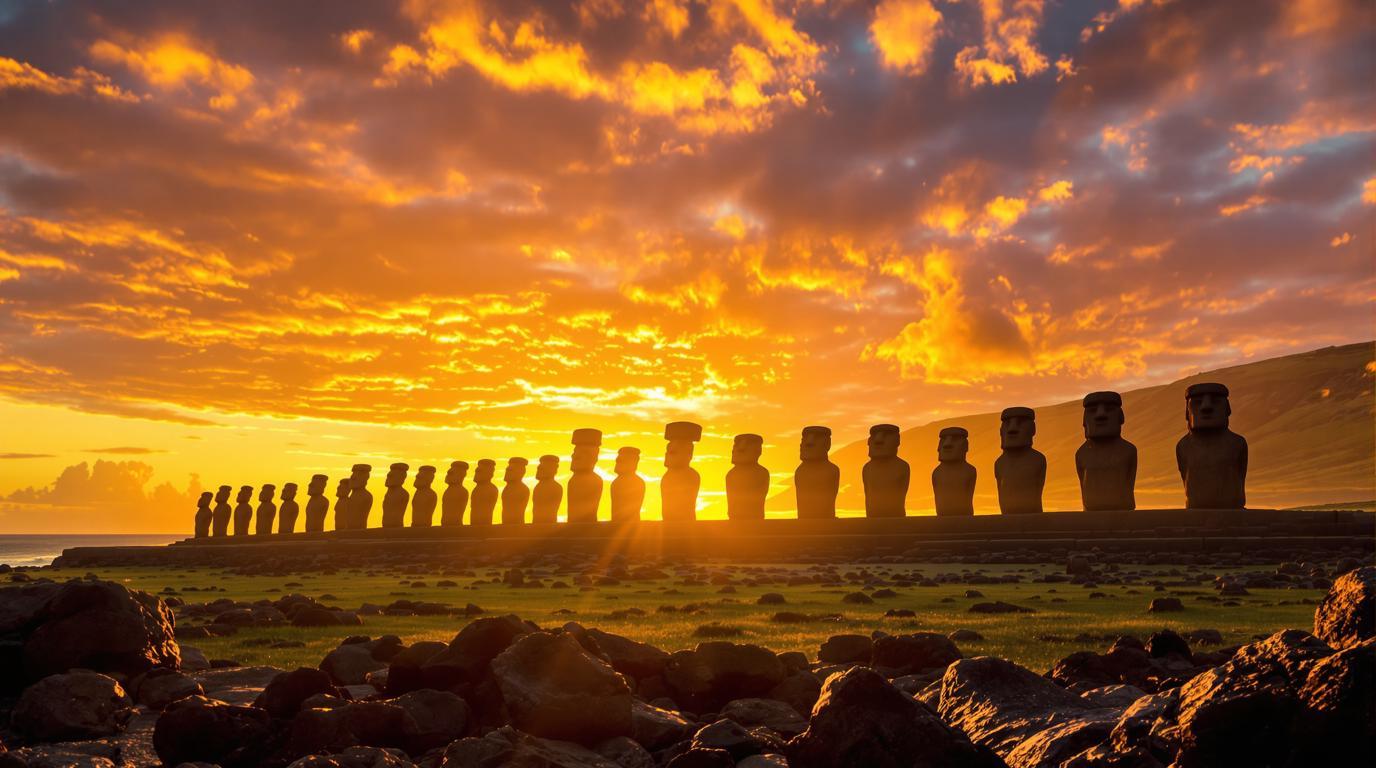Easter Island, a remote speck in the Pacific Ocean, isn’t just home to those iconic stone faces – it’s a living outdoor museum where ancient mysteries still whisper through the volcanic landscape. This Chilean territory, known to locals as Rapa Nui, sits over 2,000 miles from the nearest continent, making it one of the most isolated inhabited places on Earth.
The mysterious sentinels that defied scientific explanation
The moai – those stern-faced stone giants – represent one of humanity’s most remarkable artistic achievements. At Rano Raraku, the “moai factory,” nearly 400 unfinished statues remain frozen in time, some still attached to the volcanic rock from which they were being carved centuries ago.
The most impressive display awaits at Ahu Tongariki, where 15 restored moai stand in silent formation. Visit at sunrise when the first light creates a dramatic silhouette against the ocean backdrop. A local guide explains,
“Each moai represents an ancestor. They don’t watch the ocean – they watch over the people, protecting them with mana (spiritual power).”
The astronomical precision that rivals modern technology
Like Egypt’s ancient monuments, Easter Island’s structures demonstrate remarkable celestial alignment. The Ahu platforms were precisely positioned to mark seasonal changes and astronomical events, serving as a sophisticated calendar for the Rapa Nui people.
For the ultimate astronomical experience, book a night tour with a local elder who can explain how ancient Polynesians navigated thousands of miles of open ocean using only stars as their guide.
The ecological collapse that serves as a warning
Easter Island’s environmental history reads like a cautionary tale. Once covered in palm forests, the island was systematically deforested by its inhabitants, leading to soil erosion, food shortages, and ultimately, societal collapse.
Archaeologist Sarah Jenkins notes,
“What happened on Rapa Nui mirrors our global environmental challenges today – but on a micro scale. It’s a powerful reminder of our dependency on natural resources.”
The secluded beach where legends come alive
Anakena, the island’s only white sand beach, offers more than just swimming. This coconut palm-fringed cove is where, according to legend, the first Polynesian settlers landed around 900 CE. The restored Ahu Nau Nau moai here seem to gaze contentedly at the turquoise waters.
The shallow, protected bay makes Anakena perfect for families, while the nearby food stands serve fresh ceviche and empanadas – the perfect lunch after a morning of exploration.
The volcanic crater with a surprise inside
The massive Rano Kau crater, over a mile wide, harbors a stunning surprise: a patchwork of floating reed gardens covering its freshwater lake. The crater rim offers sweeping views that rival even Europe’s most dramatic canyons.
From here, you can spot Orongo, the ceremonial village where the dangerous “birdman cult” competition took place annually, with competitors scaling sheer cliffs and swimming to offshore islets.
The vibrant culture that refused to disappear
Despite near-extinction of native traditions following European contact, Rapa Nui culture has experienced a remarkable revival. February’s Tapati Festival showcases traditional body painting, dancing, and strength competitions that echo ancestral practices.
Master carver Tomas Tuki explains,
“Our ancestors created masterpieces with stone tools. Today, we keep their techniques alive, connecting past and present.”
Beyond the stone faces: unexpected wildlife encounters
Like the Galapagos Islands, Easter Island offers unique wildlife viewing. The crystalline waters surrounding the island host coral gardens teeming with endemic marine species found nowhere else on Earth. Book a snorkeling tour to spot sea turtles, colorful fish, and maybe even dolphins.
Where reflection meets infinity: Easter Island’s golden hour
Photographers cherish Easter Island’s quality of light, especially at Ahu Tahai, where three restored platforms create perfect sunset silhouettes. The golden hour transforms the landscape much like it does at Kyoto’s Golden Temple or Venice’s Byzantine mosaics.
Easter Island exists at the intersection of natural wonder and human ingenuity. It offers more than just a checklist of stone statues – it provides perspective on our place in history and our relationship with the planet. As you stand before these ancient sentinels, you’ll feel connected to something larger than yourself, something that stretches across oceans and centuries, reminding us that even the most remote place on Earth has profound lessons to teach.
